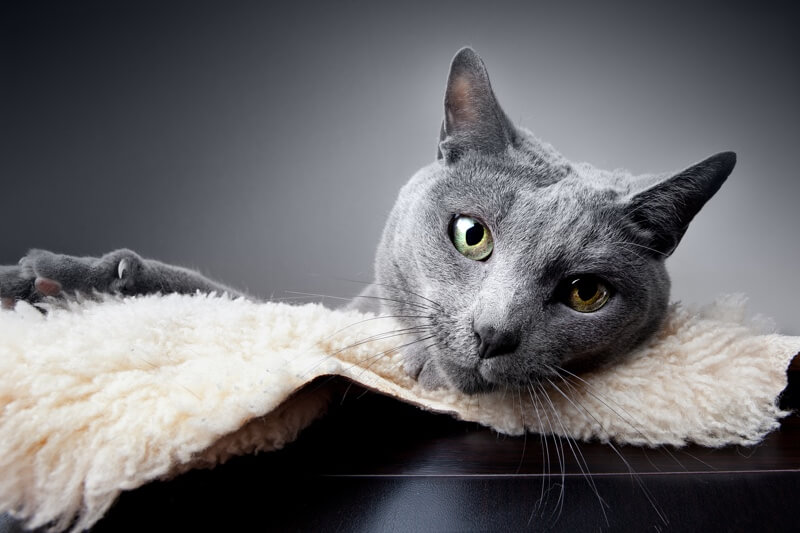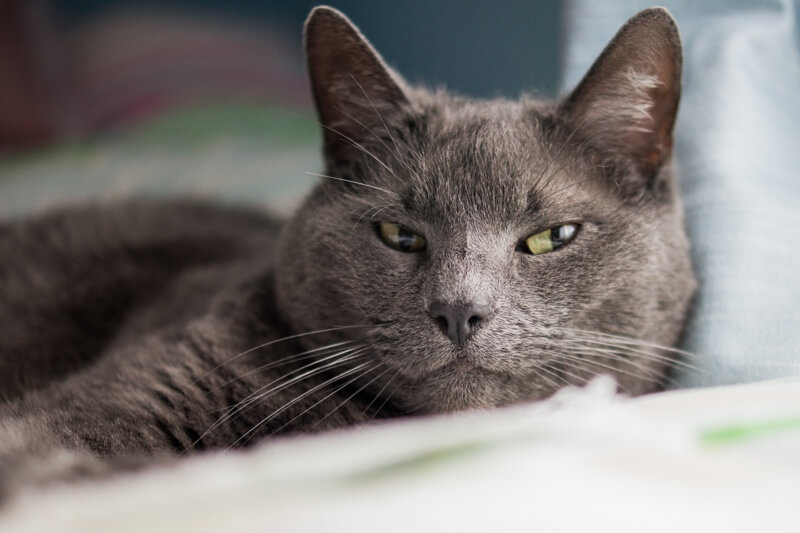Mastering the Balancing Act of School and Pet Care
Discover how juggling pet care and school can be a fun and rewarding team effort that strengthens the bond between your children and their pets.
With their shimmery blue coats, striking emerald eyes, and possible ties to Russian czars, Russian Blue cats can’t help but have a certain air of elegance. However, if you’ve spent time with one of these gorgeous kitties, you know they’re as sensitive and caring as they come – and clever, too. In fact, the more you learn about Russian Blues, the more there is to love.
Russian Blue cats belong to the same classification as the British Blue Cat, the Chartreux of France, and the Korat of Thailand. However, they are a distinct breed with unique characteristics. Russian Blues stand out because of their bright green eyes. They are also slenderer in build with a wedge-shaped head, while their blue cousins tend to be stockier and rounder in the face.
These cats grow to be approximately 10 inches tall and weigh 7-15 pounds, but how long do Russian Blue cats live? They can live 15-20 years – if not longer, if well cared for. These kitties are also referred to as Archangel Blues, Foreign Blues, or Maltese Cats.

The Russian Blue Cat is a naturally occurring breed, so we’ll never know its origin. However, they likely originated somewhere in northwest Russia. One theory is that these sleek felines descended from the esteemed pets of the Russian czars. Sadly, others speculate that the first Russian Blues lived in the wilderness and were hunted for their prized pelts – such thick, dense fur with unique coloring would have brought in the big rubles.
In any case, it’s believed that Russian sailors befriended the felines sometime around the 1860s and brought them aboard their ships as companions, most notably in the bustling port city of Arkhangelsk. This could explain how the breed came to Great Britain and Northern Europe. Arkhangelsk translates to “Archangel,” which explains how these cats earned themselves a fun nickname.

Once Russian Blue cats reached Great Britain, the breed took the cat world by storm. In 1875, Russian Blues were shown at one of the world’s first cat shows at London’s Crystal Palace. They didn’t win any prizes but left quite an impression – mainly that they were incredibly handsome.
In 1912, around the same time these cats made their way to the U.S., they were officially recognized as a breed.
After World War II, Russian Blues were in decline, but enthusiasts managed to save the bloodline. Sweden, Finland, and Denmark crossbred Russian Blues with Siamese cats to produce slightly longer and more angular kitties. They crossbred with Bluepoint Siamese and British Blues in Great Britain for thicker, stockier cats. Together, these nations helped preserve the breed so many people still love to this day.

We call them blue, but Russian Blue cats come in a range of bluish grays, anywhere from a light silver to a deep slate. Their vivid green eyes and pinkish paw pads are perfect accents regardless of shade.
Although they are shorthaired, these felines have a very dense double-layered coat. Their undercoat is soft and downy, while the outer layer is even colored with silver tips, accounting for the breed’s alluring shimmer. They say that the Russian Blue Cat’s fur is so thick and velvety that you can trace patterns with your finger, and the designs will remain until you smooth them over again.
In terms of build, Russian Blues are lean and fine-boned but muscular. They have triangular heads with pointed ears and wide, round eyes that give them a friendly, curious expression.
Cats of this breed have thick coats, but they shed very little, so a weekly brushing will remove excess hair and help distribute natural skin oils. You may want to increase brushing during the spring shedding season. Otherwise, keep up with basic grooming needs like trimming your kitty’s nails as needed and brushing their teeth with a veterinarian-approved pet toothpaste.
These cats are notoriously fussy in terms of cleanliness and routine. Keep your feline friend’s litter box spotless, or they may revert to finding a bathroom location they deem cleaner. It’s best to establish, and stick to, set mealtimes, and a time devoted to play—they love playing fetch. They are also excellent climbers and explorers, so you may need to install childproof locks on cabinet doors and block any small spaces that could be dangerous. Otherwise, these independent kitties are fine to stay at home alone for long hours while you work. You can help keep their minds engaged while you’re out with ample enrichment such as toys, scratching posts, and puzzle feeders, as well as a perch near a window.
Russian Blue cats make great companions for first-time pet parents, working singles, and families with older children.
Are you pining for your own adorable furry friend but are usually left sneezing after cat encounters? Then you may have already heard the myth that Russian Blue cats are hypoallergenic.
Is it true? Yes and no. Cats of this breed indeed have lower levels of Fel d 1, the protein in cat saliva and skin secretions responsible for your itching and wheezing. However, even small amounts of Fel d 1 can cause allergic reactions. In addition, Russian Blues also produce dander, which irritates allergies. In other words, if you have a cat allergy, you’ll likely also have Russian Blue cat allergies.*

Russian Blue cats are curious but calm, affectionate but not clingy, and very smart. They can be shy at first, but they are playful and loving once they feel comfortable.
While they are happy living with families and even other pets, Russian Blue cats tend to form a deep connection with only one person. Once they bond with someone, they will be very sensitive to their pet parent’s emotions – if you’re sad, don’t be surprised if your feline friend pats your face to cheer you up.
As a naturally occurring breed, Russian Blue cats are also naturally very healthy. Although, they are at a slightly higher risk of getting bladder stones and urinary tract issues. Plus, they can more easily be affected by obesity. These cats love food and they will always ask for more. If you have a Russian Blue Cat, consider measuring their food portions, and speak with your veterinarian about your kitty’s nutrition plan.
Of course, even with the healthiest of cats, there will always be a chance they could develop health issues throughout their lives. According to our claims data,** the top conditions that pet parents of Russian Blues submit claims for through their pet insurance plan include,
An ASPCA Pet Health Insurance plan can help cover the costs of diagnosing and treating all sorts of health conditions like these. If you have a Russian Blue or are thinking about adopting one, you should consider coverage for your feline family member. Learn more by getting a quote now.

Seriously, the more you learn about them, the cooler these cats get. Check it out:
If you’re adopting a Russian Blue Cat, you’ll want the perfect name for your pretty kitty. For example, you could go with Blueberry, Bluebell, or Blue Moon.
If you want to pay homage to your furry friend’s roots, try Ruble, Kroshka (“Baby”), or Krasavitsa (“Beautiful”). Here are some more suggestions based on famous Russian writers, composers, and dancers…with a Harry Potter reference thrown in for laughs.
After bringing home your new best pal and giving them the perfect name, the fun can really begin. Spoil your cat with their own catio, give them some treats to beat the summer heat, and fill your camera roll with every adorable thing they do.
Internal Claims Data, 2015-2020** An ASPCA Pet Health Insurance plan can help you with eligible costs for covered conditions like surgery expenses for accidents and help provide peace of mind that your pet can receive the care they need. Check out our online resources to learn more about your insurance options and get a free quote today. The information presented in this article is for educational and informational purposes only and does not constitute or substitute for the advice of your veterinarian.
(opens new window)